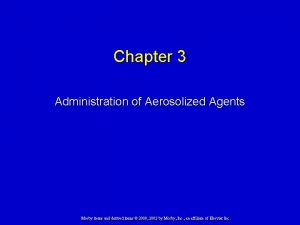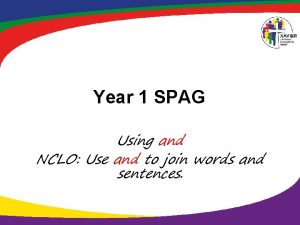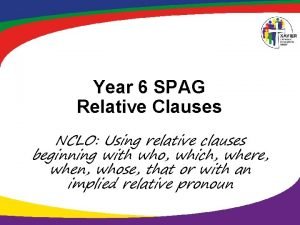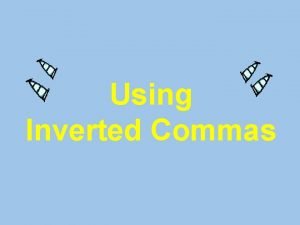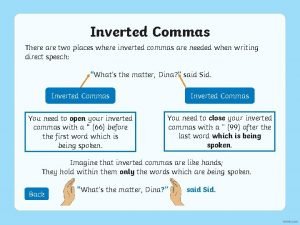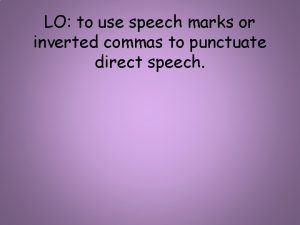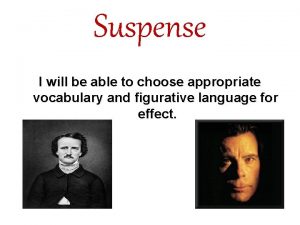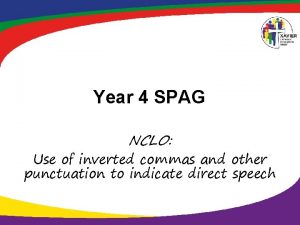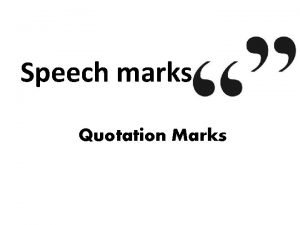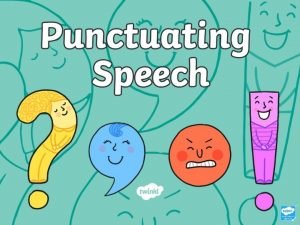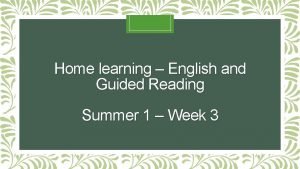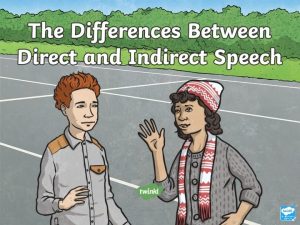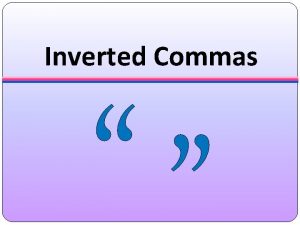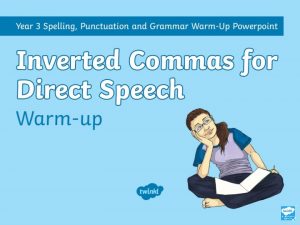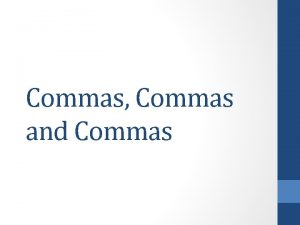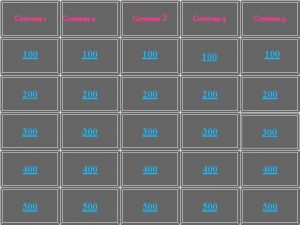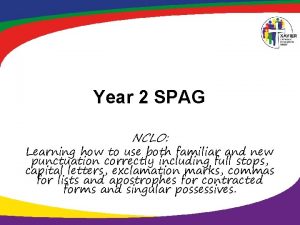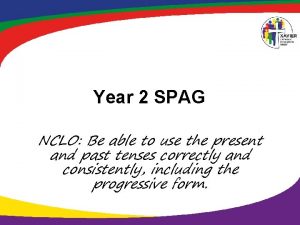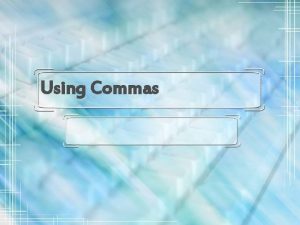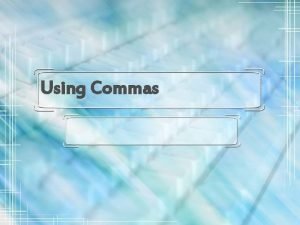Year 4 SPAG NCLO Use of inverted commas














- Slides: 14

Year 4 SPAG NCLO: Use of inverted commas and other punctuation to indicate direct speech

Using Inverted Commas to Show Direct Speech Inverted commas are punctuation marks which are placed around direct speech in a text. When inverted commas are used for this purpose, they are often referred to as speech marks. Inverted commas can be single or double. Here are examples of single and double inverted commas used to show direct speech. Both of these examples are correct. ‘Would you like a cup of tea? ’ asked Jasmine. “Would you like a cup of tea? ” asked Jasmine. Discuss – which words are the words being spoken?

Rules for using inverted commas for speech Inverted commas must only be placed around the actual spoken words. A capital letter is used after the first inverted comma. Which one of these sentences is punctuated correctly? Discuss. 1. “Where is my pen? asked Zachary. ” 2. “Where is my pen? ” asked Zachary. 3. “where is my pen? ” asked Zachary.

Correct answer 2. “Where is my pen? ” asked Zachary.

Rules for using inverted commas for speech Inverted commas must only be placed around the actual spoken words. Punctuation is required before the closing inverted comma. Which one of these sentences is punctuated correctly? Discuss. 1. “I am going to the zoo today said Ava” 2. “I am going to the zoo today” said Ava. 3. “I am going to the zoo today, ” said Ava.

Correct answer 3. “I am going to the zoo today, ” said Ava.

Setting Out Speech It is important to identify who is talking. This can be done before or after the spoken words. 1. “We need to go now!” said Maisy. 2. Maisy said, “We need to go now!” Discuss the differences between the punctuation used in both of the sentences above.

Setting Out Speech Remember a comma is usually needed before the first inverted comma when we identify who is talking before the spoken words. The grumpy man yelled, “Get out of my garden!’ The girl explained, “I’ve just come to get my ball. ” In newspaper reports colons are often used after stating who is responsible for a quote before the actual spoken words. A local man said: ‘The wind caused lots of damage. A tree fell onto the road. ’ Local MP Georgina Smith said: ‘Dangerous parking is a constant problem around schools. On-the- spot fines for people parking badly are appropriate. ’

Setting out Speech Sometimes writers identify who is talking in the middle of spoken sentences. Each separate sentence needs to punctuated correctly. “Please line up quietly, ” instructed Mr Roberts. “Andrew – please come to the front of the line. ” Discuss – How many sentences does this unit of speech contain?

Have a go! Rewrite these sentences putting inverted commas and punctuation in the correct places. 1. I will collect you from school today said mum 2. Could I have the raspberry cake asked Claire It looks tastier than the other one 3. Dad shouted Where is my tablet 4. Abigail yelled Give me back my ice-cream

Were you right? 1. “I will collect you from school today, ” said Mum. 2. “Could I have the raspberry cake? ” asked Claire. “It looks tastier than the other one. ” 3. Dad shouted, “Where is my tablet? ” 4. Abigail yelled, “Give me back my ice -cream!”

Have a go! Punctuate this dialogue correctly Mum I think I need a new bike said Kendra My bike is getting too small. That can’t be true exclaimed mum. We only bought it last year Mum it was actually two years ago and I’ve grown since then explained Kendra Well we can’t afford to get a brand new one said mum I think I’ll have a look on E-bay Great said Kendra smiling Can I look with you

How did you do? Are there any improvements you could make? “Mum I think I need a new bike, ” said Kendra. “My bike is getting too small. ” “That can’t be true!” exclaimed mum. “We only bought it last year!” “Mum it was actually two years ago and I’ve grown since then, ” explained Kendra. “Well we can’t afford to get a brand new one, ” said mum. “I think I’ll have a look on E-bay. ” “Great, ” said Kendra smiling. “Can I look with you? ”

Reflection Recap – what punctuation rules do we need to remember when using inverted commas? Now choose one of these scenarios and try writing some dialogue using inverted commas to show speech: *A disagreement between two children in which one child has accidentally broken something which belongs to the other child. *A discussion between two children about which football team they like best. *A conversation between a boy who wants to stay up late to see his Granddad and his dad who thinks it is time for him to go to bed.
 Spag nebulizer
Spag nebulizer Greater depth writing year 2
Greater depth writing year 2 Nclo lewis structure
Nclo lewis structure Nclo
Nclo Nclo
Nclo When to put inverted commas
When to put inverted commas When are inverted commas used
When are inverted commas used Inverted commas uses
Inverted commas uses Inverted commas
Inverted commas Inverted commas uses
Inverted commas uses Punctuating split speech
Punctuating split speech Inverted commas function
Inverted commas function Direct and indirect speech summary
Direct and indirect speech summary Examples of inverted commas
Examples of inverted commas Examples of inverted commas
Examples of inverted commas
